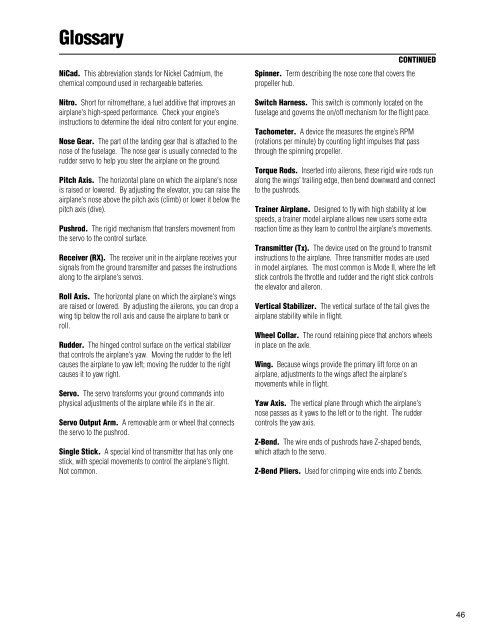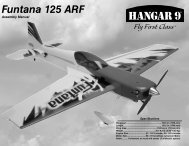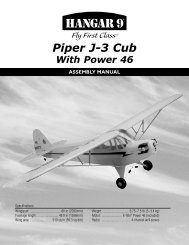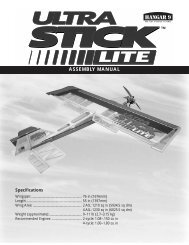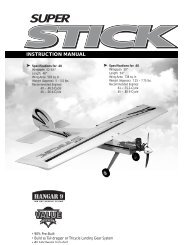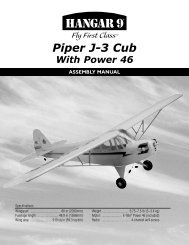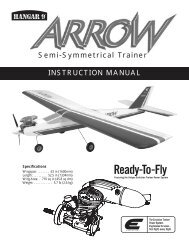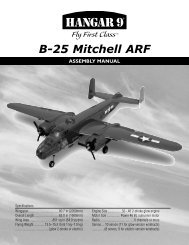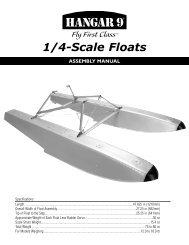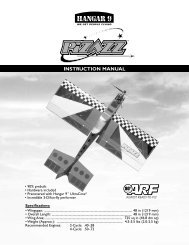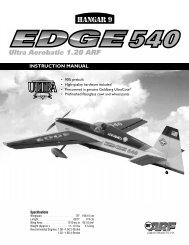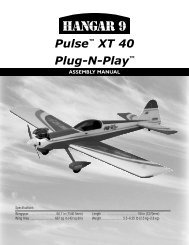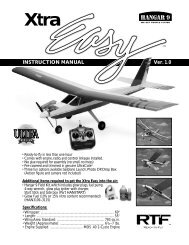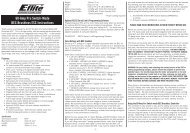instruction manual - Hangar 9
instruction manual - Hangar 9
instruction manual - Hangar 9
Create successful ePaper yourself
Turn your PDF publications into a flip-book with our unique Google optimized e-Paper software.
Glossary<br />
NiCad. This abbreviation stands for Nickel Cadmium, the<br />
chemical compound used in rechargeable batteries.<br />
Nitro. Short for nitromethane, a fuel additive that improves an<br />
airplane's high-speed performance. Check your engine’s<br />
<strong>instruction</strong>s to determine the ideal nitro content for your engine.<br />
Nose Gear. The part of the landing gear that is attached to the<br />
nose of the fuselage. The nose gear is usually connected to the<br />
rudder servo to help you steer the airplane on the ground.<br />
Pitch Axis. The horizontal plane on which the airplane's nose<br />
is raised or lowered. By adjusting the elevator, you can raise the<br />
airplane's nose above the pitch axis (climb) or lower it below the<br />
pitch axis (dive).<br />
Pushrod. The rigid mechanism that transfers movement from<br />
the servo to the control surface.<br />
Receiver (RX). The receiver unit in the airplane receives your<br />
signals from the ground transmitter and passes the <strong>instruction</strong>s<br />
along to the airplane's servos.<br />
Roll Axis. The horizontal plane on which the airplane's wings<br />
are raised or lowered. By adjusting the ailerons, you can drop a<br />
wing tip below the roll axis and cause the airplane to bank or<br />
roll.<br />
Rudder. The hinged control surface on the vertical stabilizer<br />
that controls the airplane's yaw. Moving the rudder to the left<br />
causes the airplane to yaw left; moving the rudder to the right<br />
causes it to yaw right.<br />
Servo. The servo transforms your ground commands into<br />
physical adjustments of the airplane while it’s in the air.<br />
Servo Output Arm. A removable arm or wheel that connects<br />
the servo to the pushrod.<br />
Single Stick. A special kind of transmitter that has only one<br />
stick, with special movements to control the airplane's flight.<br />
Not common.<br />
Spinner. Term describing the nose cone that covers the<br />
propeller hub.<br />
CONTINUED<br />
Switch Harness. This switch is commonly located on the<br />
fuselage and governs the on/off mechanism for the flight pace.<br />
Tachometer. A device the measures the engine’s RPM<br />
(rotations per minute) by counting light impulses that pass<br />
through the spinning propeller.<br />
Torque Rods. Inserted into ailerons, these rigid wire rods run<br />
along the wings’ trailing edge, then bend downward and connect<br />
to the pushrods.<br />
Trainer Airplane. Designed to fly with high stability at low<br />
speeds, a trainer model airplane allows new users some extra<br />
reaction time as they learn to control the airplane's movements.<br />
Transmitter (Tx). The device used on the ground to transmit<br />
<strong>instruction</strong>s to the airplane. Three transmitter modes are used<br />
in model airplanes. The most common is Mode II, where the left<br />
stick controls the throttle and rudder and the right stick controls<br />
the elevator and aileron.<br />
Vertical Stabilizer. The vertical surface of the tail gives the<br />
airplane stability while in flight.<br />
Wheel Collar. The round retaining piece that anchors wheels<br />
in place on the axle.<br />
Wing. Because wings provide the primary lift force on an<br />
airplane, adjustments to the wings affect the airplane's<br />
movements while in flight.<br />
Yaw Axis. The vertical plane through which the airplane's<br />
nose passes as it yaws to the left or to the right. The rudder<br />
controls the yaw axis.<br />
Z-Bend. The wire ends of pushrods have Z-shaped bends,<br />
which attach to the servo.<br />
Z-Bend Pliers. Used for crimping wire ends into Z bends.<br />
46


